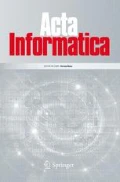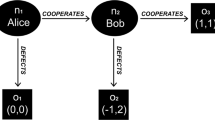Abstract
The overall aim of our research is to develop techniques to reason about the equilibrium properties of multi-agent systems. We model multi-agent systems as concurrent games, in which each player is a process that is assumed to act independently and strategically in pursuit of personal preferences. In this article, we study these games in the context of finite-memory strategies, and we assume players’ preferences are defined by a qualitative and a quantitative objective, which are related by a lexicographic order: a player first prefers to satisfy its qualitative objective (given as a formula of linear temporal logic) and then prefers to minimise costs (given by a mean-payoff function). Our main result is that deciding the existence of a strict \(\epsilon \) Nash equilibrium in such games is 2ExpTime-complete (and hence decidable), even if players’ deviations are implemented as infinite-memory strategies.

Similar content being viewed by others
Notes
We remark that strict Nash equilibria appear naturally in the study of evolutionary game-theory [41]. Indeed, every strict Nash equilibrium in a symmetric game is evolutionary stable.
The transition systems on which these games are played are sometimes called “concurrent game structures” and sometimes “arenas”. Note that “concurrent” in this context simply means that players move at the same time, i.e., synchronously.
Note that the arena is similar to the one of [45, Fig. 3 in Lemma 7] to prove that Multi mean-payoff games require in general infinite memory strategies to be played optimally.
This definition extends the one provided in [43] which considers mean-payoff games.
This is an abuse of notation, as the transition functions of the two strategies are defined on a different set of decisions. Here we mean that the transition functions of \(\mathbf {\upsigma }'\) simply copy the ones in \(\mathbf {\upsigma }\) by ignoring the components expressed by agents \(a_{1}\) and \(a_{2}\)
With another abuse of notation, we here mean the restriction of sequences in \({\text {A}\!\text {P}} \cup \{p\}\) to sequences in \({\text {A}\!\text {P}}\).
References
Alechina, N., Logan, B., Nga, N.H., Raimondi, F.: Model-checking for resource-bounded ATL with production and consumption of resources. CoRR, arXiv:1504.06766 (2015)
Almagor, S., Kupferman, O., Perelli, G.: Synthesis of controllable Nash equilibria in quantitative objective game. In: Proceedings of the Twenty-Seventh International Joint Conference on Artificial Intelligence, IJCAI 2018, July 13–19, 2018, Stockholm, Sweden, pp. 35–41 (2018)
Alur, R.: Principles of Cyber-Physical Systems. The MIT Press, Cambridge (2015)
Alur, R., Henzinger, T.A., Kupferman, O.: Alternating-time temporal logic. J. ACM 49(5), 672–713 (2002)
Bang-Jensen, J., Gutin, G.: Digraphs: Theory, Algorithms and Applications. Springer, Berlin (2008)
Binmore, K.: Fun and Games: A Text on Game Theory. D. C. Heath and Company, Lexington (1992)
Bloem, R., Chatterjee, K., Henzinger, T.A., Jobstmann, B.: Better quality in synthesis through quantitative objectives. In: CAV’09, pp. 140–156 (2009)
Bonzon, E., Lagasquie, M.-C., Lang, J., Zanuttini, B.: Boolean games revisited. In: Proceedings of the Seventeenth European Conference on Artificial Intelligence (ECAI-2006), Riva del Garda, Italy (2006)
Bouyer, P., Brenguier, R., Markey, N., Ummels, M.: Pure Nash equilibria in concurrent deterministic games. Log. Methods Comput. Sci. (2015). https://doi.org/10.2168/LMCS-11(2:9)2015
Brafman, R., Domshlak, C.: On the complexity of planning for agent teams and its implications for single agent planning. Artif. Intell. 198, 52–71 (2013)
Brafman, R., Domshlak, C., Engel, Y., Tennenholtz, M.: Planning games. In: Proceedings of the Twenty-First International Joint Conference on Artificial Intelligence (IJCAI-09) (2009)
Bruyère, V., Meunier, N., Raskin, J.-F.: Secure equilibria in weighted games. In: CSL-LICS’14, pp. 26:1–26:26 (2014)
Bulling, N., Goranko, V.: How to be both rich and happy: combining quantitative and qualitative strategic reasoning about multi-player games (extended abstract). In: SR’13, pp. 33–41 (2013
Chatterjee, K., Doyen, L.: Energy parity games. Theor. Comput. Sci. 458, 49–60 (2012)
Chatterjee, K., Henzinger, T.A., Jurdzinski, M.: Mean-payoff parity games. In: LICS’05, pp. 178–187 (2005)
Chatterjee, K., Henzinger, T.A., Piterman, N.: Strategy logic. Inf. Comput. 208(6), 677–693 (2010)
Clarke, E.M., Grumberg, O., Peled, D.A.: Model Checking. The MIT Press, Cambridge (2000)
Demri, S., Goranko, V., Lange, M.: Temporal Logics in Computer Science. Cambridge University Press, Cambridge (2017)
Dunne, P.E., Kraus, S., van der Hoek, W., Wooldridge, M.: Cooperative Boolean games. In: Proceedings of the Seventh International Joint Conference on Autonomous Agents and Multiagent Systems (AAMAS-2008), Estoril, Portugal (2008)
Ehrenfeucht, A., Mycielski, J.: Positional strategies for mean payoff games. Int. J. Game Theory 8(2), 109–113 (1979)
Emerson, E.A.: Temporal and modal logic. In: van Leeuwen, J. (ed.) Handbook of Theoretical Computer Science Volume B: Formal Models and Semantics, pp. 996–1072. Elsevier, Amsterdam (1990)
Fisman, D., Kupferman, O., Lustig, Y.: Rational synthesis. In: TACAS’10, pp. 190–204. Springer (2010)
Grant, J., Kraus, S., Wooldridge, M., Zuckerman, I.: Manipulating Boolean games through communication. In: Proceedings of the Twenty-Second International Joint Conference on Artificial Intelligence (IJCAI-11), Barcelona, Catalonia, Spain (2011)
Gutierrez, J., Harrenstein, P., Wooldridge, M.: Iterated Boolean games. Inf. Comput. 242, 53–79 (2015)
Gutierrez, J., Harrenstein, P., Wooldridge, M.: From model checking to equilibrium checking: reactive modules for rational verification. Artif. Intell. 248, 123–157 (2017)
Gutierrez, J., Harrenstein, P., Perelli, G., Wooldridge, M.J.: Nash equilibrium and bisimulation invariance. Log. Methods Comput. Sci. (2019). https://doi.org/10.23638/LMCS-15(3:32)2019
Gutierrez, J., Murano, A., Perelli, G., Rubin, S., Wooldridge, M.J.: Nash equilibria in concurrent games with lexicographic preferences. In: IJCAI, pp. 1067–1073 (2017)
Harrenstein, P., van der Hoek, W., Meyer, J.-J.Ch., Witteveen, C.: Boolean games. In: van Benthem, J. (ed.) Proceeding of the Eighth Conference on Theoretical Aspects of Rationality and Knowledge (TARK VIII), Siena, Italy, pp. 287–298 (2001)
Ianovski, E., Ong, L.: The complexity of decision problems about equilibria in two-player Boolean games. Artif. Intell. 261, 1–15 (2018)
Jurdzinski, M.: Deciding the winner in parity games is in UP \(\cap \) co-UP. Inf. Process. Lett. 68(3), 119–124 (1998)
Kosaraju, S.R., Sullivan, G.: Detecting cycles in dynamic graphs in polynomial time. In: STOC’88, pp. 398–406. ACM (1988)
Kupferman, O., Perelli, G., Vardi, M.Y.: Synthesis with rational environments. Ann. Math. Artif. Intell. 78(1), 3–20 (2016)
Matousek, J., Gärtner, B.: Understanding and Using Linear Programming. Springer, Berlin (2007)
Megiddo, N., Papadimitriou, C.H.: On total functions, existence theorems and computational complexity. Theor. Comput. Sci. 81(2), 317–324 (1991)
Osborne, M.J., Rubinstein, A.: A Course in Game Theory. The MIT Press, Cambridge (1994)
Piterman, N.: From nondeterministic Büchi and Streett automata to deterministic parity automata. Log. Methods Comput. Sci. 3(3), 255–264 (2007)
Pnueli, A.: The temporal logic of programs. In: Proceedings of the Eighteenth IEEE Symposium on the Foundations of Computer Science, pp. 46–57 (1977)
Pnueli, A., Rosner, R.: On the synthesis of a reactive module. In: POPL’89, pp. 179–190. ACM (1989)
Rosner, R.: Modular synthesis of reactive systems. Ph.D. Thesis, Weizmann (1991)
Shoham, Y., Leyton-Brown, K.: Multiagent Systems: Algorithmic, Game-Theoretic, and Logical Foundations. Cambridge University Press, Cambridge (2008)
Smith, J.M.: Evolution and the Theory of Games. Cambridge University Press, Cambridge (1982)
Tarjan, R.E.: Depth-first search and linear graph algorithms. SIAM J. Comput. 1(2), 146–160 (1972)
Ummels, M., Wojtczak, D.: The complexity of Nash equilibria in limit-average games. In: CONCUR’11, pp. 482–496 (2011)
Vardi, M.Y.: An automata-theoretic approach to linear temporal logic. In: Logics for Concurrency—Structure Versus Automata (8th Banff Higher Order Workshop, August 27–September 3, 1995, Proceedings), pp. 238–266 (1995)
Velner, Y., Chatterjee, K., Doyen, L., Henzinger, T.A., Rabinovich, A.M., Raskin, J.-F.: The complexity of multi-mean-payoff and multi-energy games. Inf. Comput. 241, 177–196 (2015)
Wooldridge, M., Endriss, U., Kraus, S., Lang, J.: Incentive engineering for Boolean games. Artif. Intell. 195, 418–439 (2013)
Wooldridge, M., Gutierrez, J., Harrenstein, P., Marchioni, E., Perelli, G., Toumi, A.: Rational verification: from model checking to equilibrium checking. In: AAAI’16, pp. 4184–4191 (2016)
Zwick, U., Paterson, M.: The complexity of mean payoff games on graphs. TCS 158(1&2), 343–359 (1996)
Acknowledgements
The authors would like to thank the reviewers for their careful reading of preliminary versions of this manuscript. This allowed us to significantly improve the quality and solidity of our results.
Author information
Authors and Affiliations
Corresponding author
Additional information
Publisher's Note
Springer Nature remains neutral with regard to jurisdictional claims in published maps and institutional affiliations.
We gratefully acknowledge the financial support of ERC Advanced Investigator Grant 291528 at Oxford (J. Gutierrez, G. Perelli, and M. Wooldridge), INdAM Research Project 2017 “Logica e Autonomi per il Model Checking” at Naples (A. Murano), Marie Curie Fellowship of the Istituto Nazionale di Alta Matematica (S. Rubin), the EPSRC Centre for Doctoral Training in Autonomous Intelligent Machines and Systems EP/L015897/1 and the Ian Palmer Memorial Scholarship (T. Steeples). A preliminary version of this work appeared in [27].
Rights and permissions
About this article
Cite this article
Gutierrez, J., Murano, A., Perelli, G. et al. Equilibria for games with combined qualitative and quantitative objectives. Acta Informatica 58, 585–610 (2021). https://doi.org/10.1007/s00236-020-00385-4
Received:
Accepted:
Published:
Issue Date:
DOI: https://doi.org/10.1007/s00236-020-00385-4




